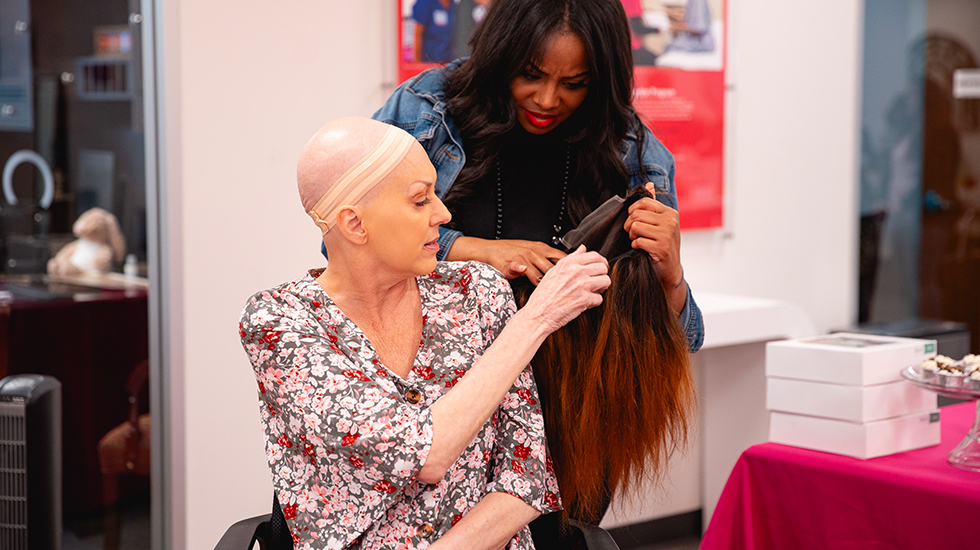


One of the most common side effects of using chemotherapy to treat cancer is hair loss. For many women experiencing chemotherapy-related hair loss, it’s about more than just hair. The physical change due to treatment can also affect cancer patients psychologically and emotionally.
There are different options available to help patients cope with and manage chemo hair loss. Some may choose to wear head coverings, such as hats, scarves, or turbans, to help keep their scalps warm or add some flair to their wardrobe. Others may choose to wear wigs during their treatment, either choosing a wig that matches their usual style or perhaps using this time to experiment with hairstyles they’ve never worn before. And some people may choose not to cover their scalp at all.
The tips in this post are meant to help those facing chemo-related hair loss feel educated and supported during their journey and empowered to make decisions that are right for them along the way.
What to expect with hair loss during cancer treatment
Why wigs matter during cancer treatment
Wig types and styles for cancer patients
Wig fiber options
Wig and hairpiece style options
Common wig and hairpiece constructions
How to choose the right wig during cancer treatment
Choosing a wig color, cut, and style
Wig-wearing tips
Wig styling tips
Wig care and maintenance
Where to find wigs for chemotherapy patients
Financial assistance for wigs
For those who want to wear a wig during cancer treatment, the process of choosing just the right one can be overwhelming. To simplify the process, there are several tips to keep in mind when considering wigs for cancer patients.
Below are some common questions about chemotherapy hair loss to help patients and their loved ones know what to expect.
Chemotherapy is a systemic treatment, meaning it travels throughout the whole body, attacking both cancerous and healthy cells alike. Some of the healthy cells that chemo drugs affect are cells in the hair roots, leading to hair loss.
Hair loss can occur anywhere on the body where hair grows, including the scalp, eyebrows, eyelashes, armpits, pubic area, and arms and legs. Whether your hair falls out completely or only thins, and the areas affected, depend on the type and dosage of chemo you receive.
While not all types of chemotherapy drugs cause hair loss, the majority of cancer patients receiving chemotherapy will experience it. According to the National Institutes of Health, approximately 65% of cancer patients receiving chemotherapy will experience hair loss as a treatment side effect. For breast cancer patients specifically, approximately 99.9% will experience hair loss within 18 days of beginning chemotherapy.
The extent of hair loss depends on the type of treatment you are on. Some chemo drugs cause more aggressive hair loss, while other drugs may cause a gradual thinning of the hair or even no hair loss at all. You can ask your doctor what type of chemotherapy you are on and how much hair loss is to be expected.
When someone begins to lose their hair due to chemo, it can either fall out quickly in clumps or thin gradually. When hair loss begins, you may start to notice more loose hairs on your pillow, in your hairbrush, or in the shower drain. Your scalp may also feel tender to the touch. Hair loss will likely continue throughout your treatment and up to a few weeks after.
The good news is that chemo-induced hair loss is usually temporary, with 98% of patients experiencing hair regrowth within 3 months of completing their treatment.
According to research studies, chemotherapy-induced hair loss, also called chemotherapy-induced alopecia (CIA), is one of the most commonly reported and psychologically distressing adverse side effects of cancer treatment. It is estimated that 65% of patients undergoing chemotherapy will experience hair loss and the physiological and emotional stress that can come with it, with some patients experiencing anxiety, depression, and lowered self-confidence due to their hair loss.
Breast cancer survivor and advocate Jessica Baladad explains the psychological impact of her hair loss journey: “The loss of hair is the first external sign that your breast cancer diagnosis is transforming your body, but getting through that first initial shock [of hair loss] prepares you for making difficult decisions. Sometimes when we do something new, our brains tell us, ‘Oh, no. Don’t do that. It’s scary!’ The reality is that new experiences are just that: new. They are not inherently dangerous. Our brains keep us safe by helping us stay within the lines of our normal, but when we are confronted with unforeseen challenges, such as those with breast cancer, we have the capacity to do the hard things.”
This is where wigs for cancer patients may come in. To address the emotional impact of hair loss from chemotherapy, many people choose to wear a wig in order to boost their self-confidence and help maintain a sense of normalcy in a season that is anything but normal. In a situation where individuals may have very little control over what is happening in and to their bodies, being able to make decisions and control at least one thing—their hair—can have a big psychological impact.
There are multiple types and styles of wigs for cancer patients to choose from. The type and style chosen may depend on how much hair loss the person has experienced and what their objective is for wearing a wig. Other factors to consider may be the cost of the wig and the type of hair used to make it.
Wig fibers are the materials used to make the hair portion of a wig. There are generally three types of wig fibers to choose from: synthetic, human hair, and blended.
Synthetic wigs: These wigs are made from artificial fibers like polyester or acrylic and are widely available. Synthetic wigs are more affordable, typically ranging from $100 to $500, and are easier to maintain than human hair wigs, allowing for quick styling and a low-maintenance experience.
Human hair wigs: These wigs are made from real human hair. Human hair wigs often offer a more natural look and feel than synthetic wigs, can be styled in different ways, and have a longer lifespan than synthetic wigs. However, human hair wigs are often more expensive, usually $500+, and require more maintenance than synthetic wigs.
Blended wigs: Blended wigs are made from a combination of both human hair and synthetic hair fibers. They offer a natural look and feel as well as low-maintenance styling and care.
Whether you choose a synthetic wig or a human hair wig, there are different options for wig styles to choose from.

Full wig: A full wig is a type of wig that covers the entire head. A full wig may be ideal for someone who has lost all of their hair and wishes to fully cover their scalp.
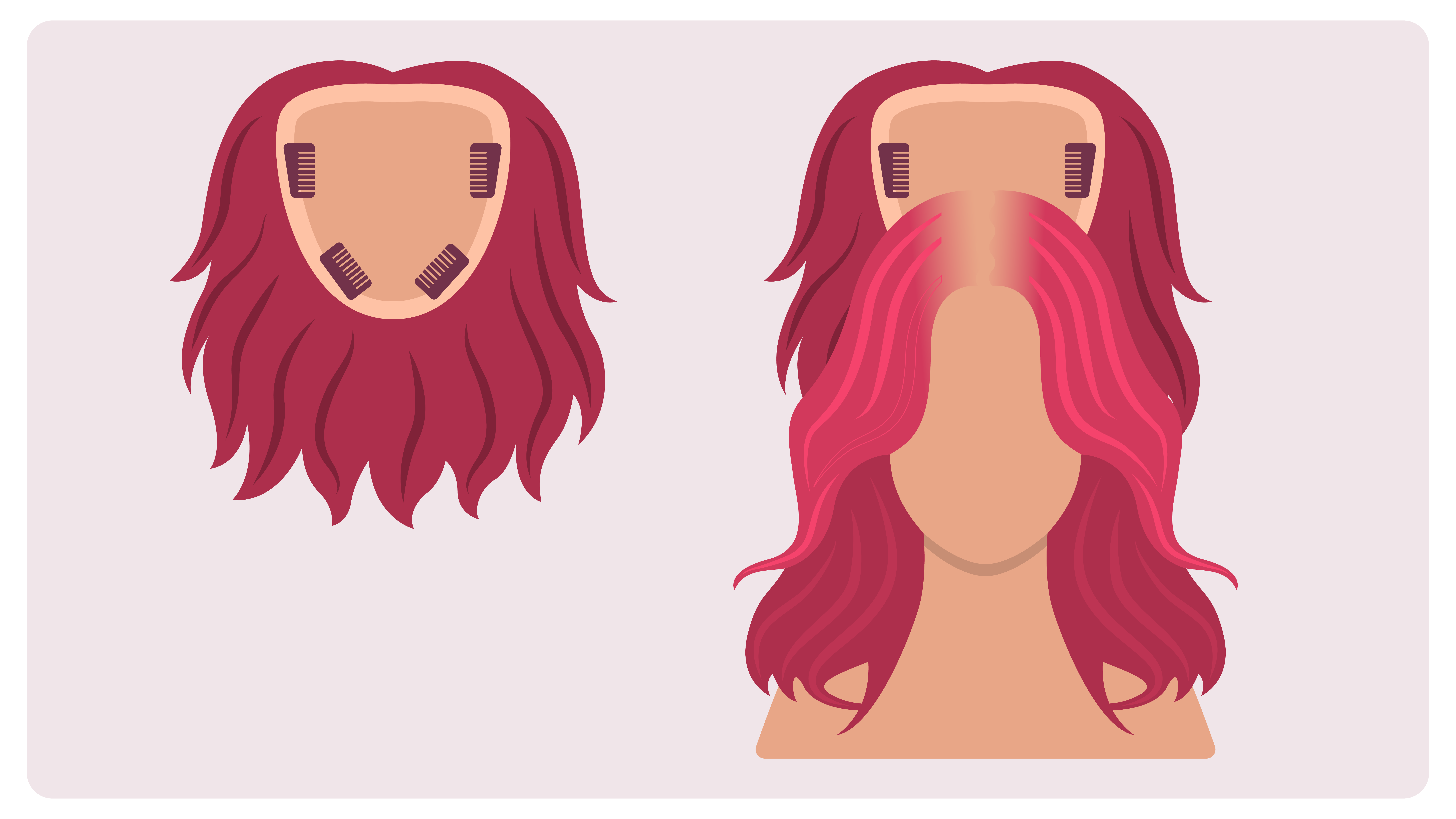
Hair topper: Also called a top piece, a hair topper is a hairpiece that adds coverage, volume, or length to a portion of the head by clipping the piece into the existing hair. A hair topper may be ideal for someone who is experiencing hair thinning.
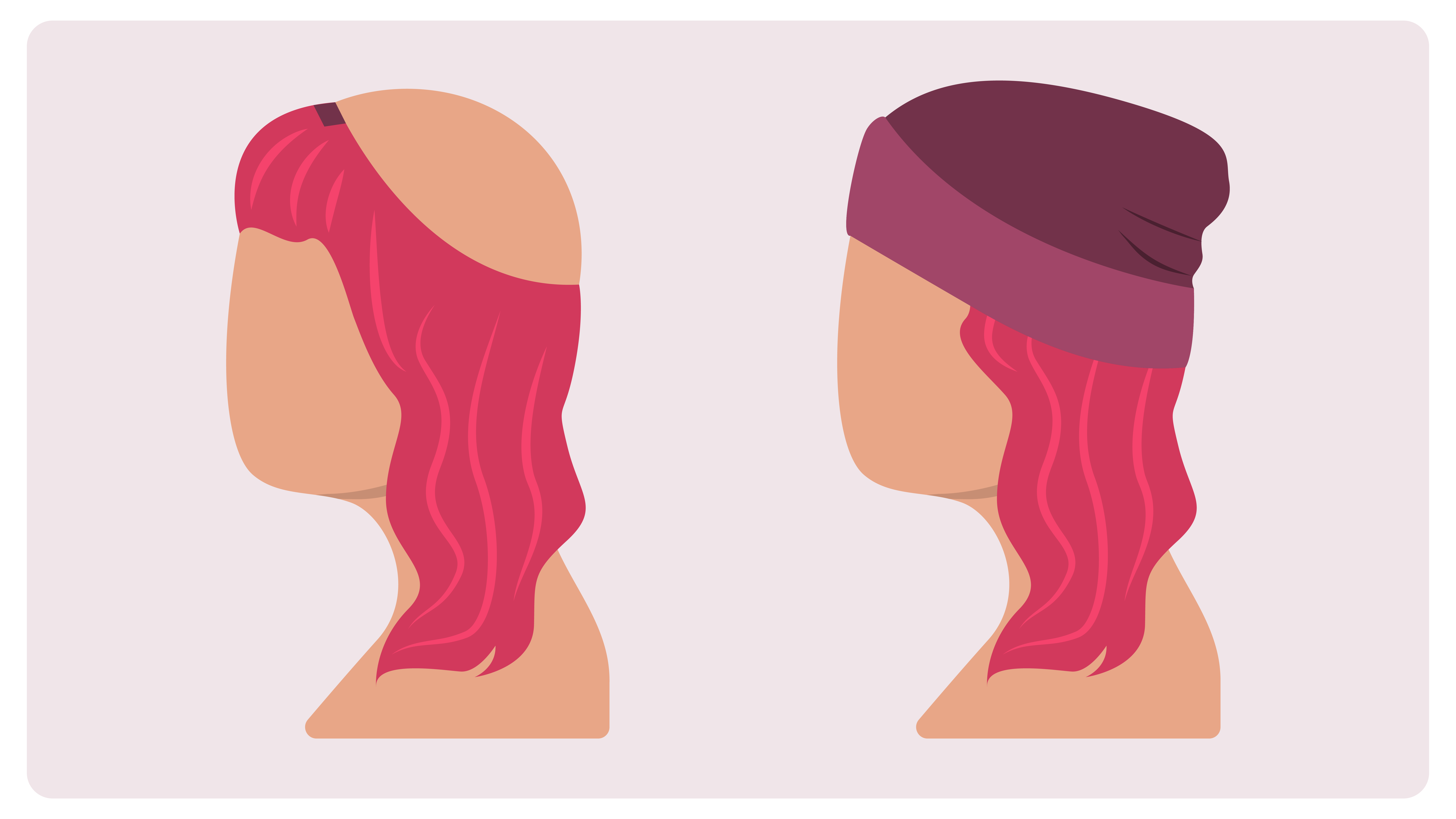
Halo: A halo is a hairpiece that is designed to be worn with a hat or other head covering. Halos have hair on the sides but are open on the top to keep the scalp cooler. This open portion is then covered by a hat, scarf, or other head covering. A halo may be ideal for someone who has lost all their hair, has experienced thinning, or is in the process of growing hair.
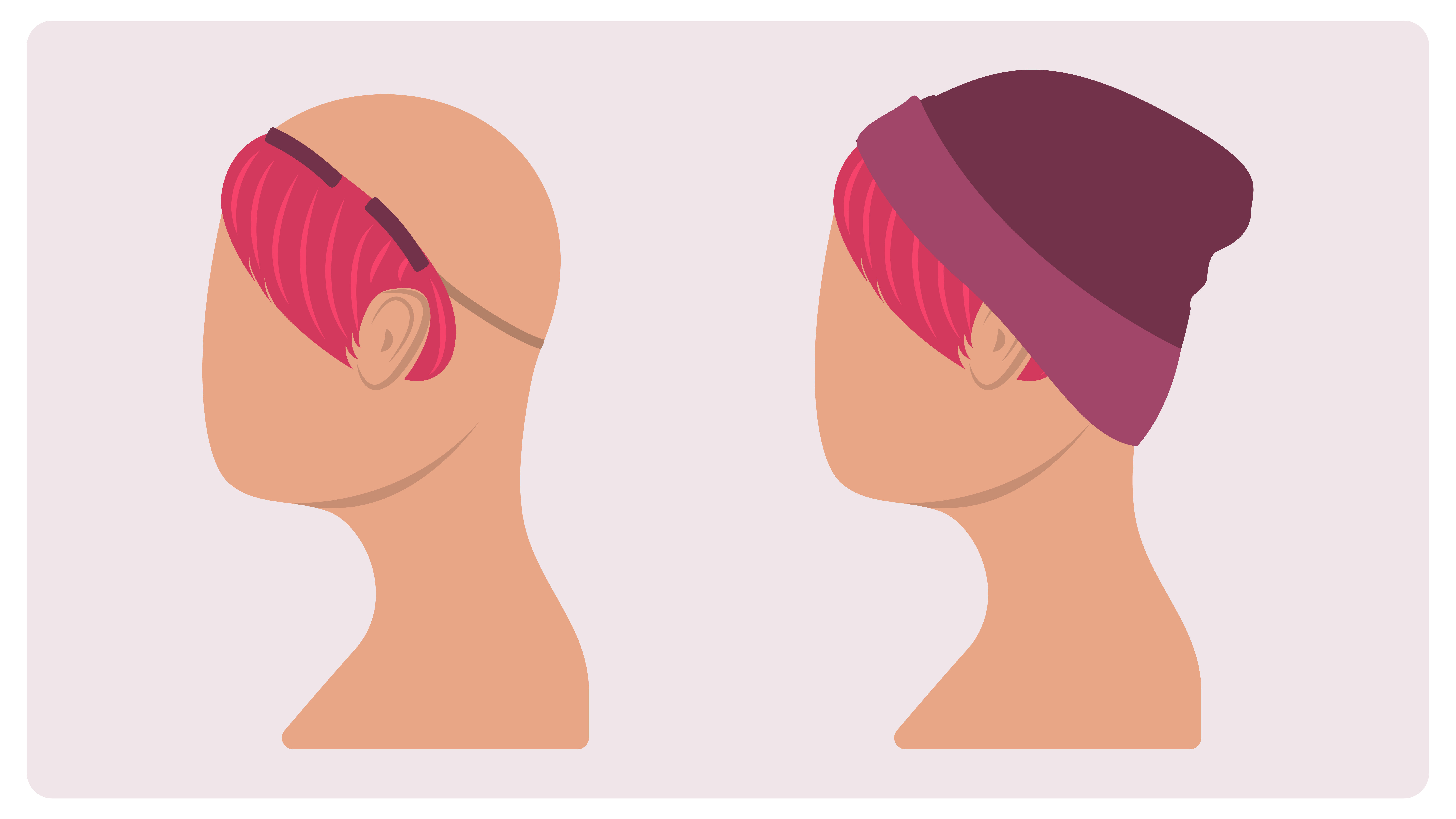
Bangs attachment: This type of hairpiece is designed to attach to the front of hats, scarves, or turbans to provide the look of bangs or hair peeking out from under the head covering. A bangs attachment may be ideal for someone who has lost all their hair or experienced thinning and wants to cover their scalp with a head covering.
Wig construction refers to the way a wig is built, specifically focusing on the wig cap, which is the foundation that holds the hair. Wig cap construction can impact fit, comfort, and the overall appearance of the wig. If you choose to wear a wig or other hairpiece due to hair loss or thinning, there are different construction types to choose from, including lace front, full lace, monofilament, and hand-tied wigs.
Lace front wig: A lace front wig has a sheer panel of lace that matches your skin tone along the front hairline of the wig. This creates a natural-looking hairline that blends in with your skin.
Full lace wig: A full lace wig uses a lace cap that matches your skin tone and covers the entire head. A full lace wig allows you to part the hair in any direction and create different styles with the hair, including ponytails. Full lace wigs are usually considered the most natural-looking.
Monofilament wig: Similar to full lace wigs, monofilament wigs use a cap to cover the crown of the head and mimic the appearance of a natural scalp and hair growth. Considered more durable than full lace wigs, monofilament wigs are sometimes described as less breathable.
Hand-tied wig: These wigs are similar in appearance to full lace wigs but are handmade rather than made with a machine. The hand-tying of each strand or fiber of hair to the wig cap creates an extremely natural look. Hand-tied wigs tend to be lightweight and breathable.
When facing hair loss due to chemotherapy, it is a good idea to plan ahead before hair loss begins, especially if you want to match your chosen wig to your natural hairstyle and color. There are additional factors to consider as well, including comfort, budget, style, and ease of maintenance of a wig.
In addition to choosing a wig that is the best type and style for you, it is important that your wig fits properly in order to look the most natural and be the most comfortable. If you are purchasing a wig in a store, the store staff will be able to help fit the wig. But if you are buying a wig online, the tips and steps below will help you measure before ordering.
When measuring your head for a wig, keep the following tips in mind:
There are three steps in measuring your head for a wig:
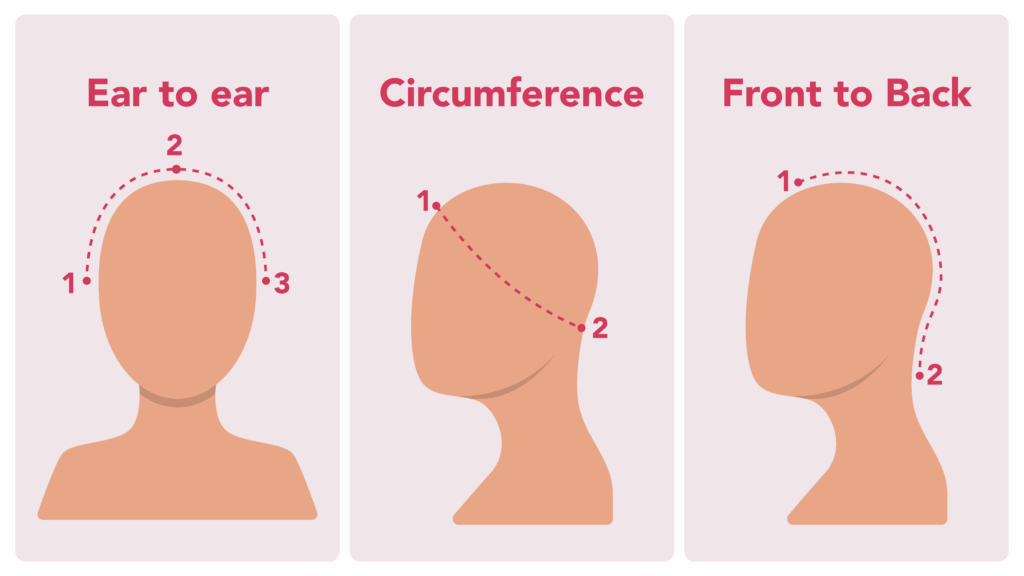
Most wig manufacturers use standard size charts for their wigs. However, be sure to double-check the size options and measurements of the manufacturer you choose to order from. Most wigs will come with adjustable straps inside to also help get a secure and accurate fit.
Wig Size | Circumference | Front to Back | Side to Side |
Petite | 21″ | 13 ⅜” | 12 ⅞ – 13” |
Average | 21 ½” | 14 ½ – 14 ¾” | 13 ⅜” |
Large | 23″ | 14 ⅞ – 15 ¼” | 13 ⅞” |
When deciding on a wig, some people may choose to have it closely match their usual hair color and style, while others may opt for a different color or style from their usual.
When choosing the right wig style for you, consider your natural face shape.
When considering wig length, keep your lifestyle and maintenance needs in mind. Long-length wigs tend to require more upkeep and maintenance than shorter styles.
When you receive your wig, you will need to fit it properly to your head for the most comfortable experience. Many wigs come with adjustable straps to fine-tune the fit, in addition to the overall size of the wig selected.
To get the most wear and comfort out of your wig, follow these tips:
Use the following tips and suggestions to style your wig:
Wigs require special care and maintenance to keep them looking fresh and natural and to increase their longevity.
Independently owned wig shops and boutiques offer wigs for purchase, including for chemotherapy patients. Certain cancer centers may even have a wig shop as part of their patient offerings. Check with your treatment center to see if they have any recommendations for wig shops or manufacturers. Cancer patient and survivor support groups are also a great place to ask for wig recommendations.
Wigs are often available for purchase online as well. If purchasing a wig online, be sure that the measurements of your head size are accurate and the wig you order is the closest in size to those measurements. Because it can sometimes be difficult to tell the true color of a wig online, ask if the online seller has sample color swatches they can send you, and inquire about their returns and exchange policy before placing an order.
Insurance coverage for wigs varies from plan to plan and even from state to state. However, most health insurance plans do not cover wigs as cosmetic items. Sometimes, if the wig is prescribed as “medically necessary” by a doctor as a means to treat chemotherapy hair loss, certain insurance plans may cover it. Check with your insurance company to determine if wigs are covered as part of cancer chemotherapy treatment.
Take note that some insurance companies may use language such as “cranial prosthesis” and “medical wig” to refer to wigs for chemotherapy patients.
Whether synthetic or human hair, wigs can be costly. If you are in need of financial assistance to help with the cost of a wig due to chemotherapy-related hair loss, contact the following organizations to see if they can help you.
No matter how a woman chooses to manage chemotherapy-related hair loss—whether by embracing her baldness, using head coverings, or choosing to wear a wig—the important thing is that she feels comfortable, physically and emotionally, as she continues her treatment journey.
Mayo Clinic
National Institutes of Health
National Institutes of Health
American Cancer Society
wigs.com
National Breast Cancer Foundation is here for you as you navigate a breast cancer diagnosis. Visit our website to learn about NBCF breast cancer support groups, obtain free educational resources, or find a patient navigator in your area.
Donations are always appreciated, but there are lots of great ways to get involved.
Hi, I found this article very informative. I wish I had this info when I went through therapy. One thing I have found is that there are companies that have a full line of synthetic wigs that are heat resistant. One company, SBS, Styles by Soma, carries hundreds of wigs of all styles, colors and sizes. During their live shows on Facebook and on their website, many are discounted and affordable. Maybe this can be a help to other women and men. Thank you.